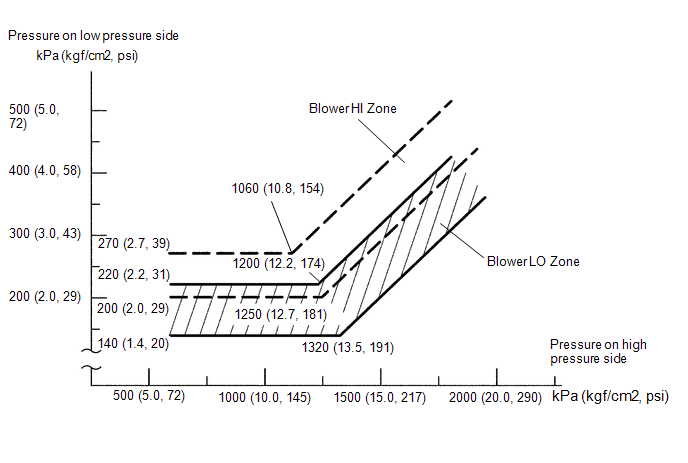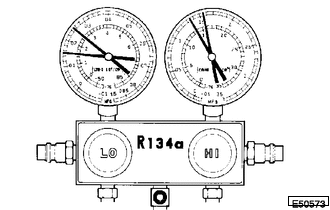Toyota Tacoma (2015-2018) Service Manual: On-vehicle Inspection
ON-VEHICLE INSPECTION
PROCEDURE
1. INSPECT REFRIGERANT PRESSURE WITH MANIFOLD GAUGE SET
(a) This is a method to specify trouble areas by using a manifold gauge set. Read the manifold gauge pressure when the following conditions are established.
Test conditions:
- Engine has been warmed up.
- All doors are fully open.
- A/C switch is ON.
- Engine is running at 1,500 rpm.
- Air inlet mode selector damper is set at recirculation.
- Temperature control switch is in MAX. COLD position.
- Blower speed control switch is in HI position.
- Air temperature at the air inlet is 30 to 35°C (86 to 95°F).
Gauge readings (Reference)

|
(1) When the refrigerant volume is proper: Gauge reading: Low pressure side: 150 to 250 kPa (1.5 to 2.5 kgf/cm2, 22 to 36 psi) High pressure side: 1370 to 1570 kPa (14.0 to 16.0 kgf/cm2, 199 to 228 psi) |
|
(2) When there is moisture in the refrigeration system:

|
Symptoms |
Probable Cause |
Diagnosis |
Corrective Actions |
|---|---|---|---|
|
During operation, pressure on low pressure side cycles between normal and vacuum |
Moisture in refrigeration system freezes at expansion valve orifice, causing temporary stop of cycle. However, when melted, normal state restored |
|
|
(3) When cooling is insufficient:

|
Symptoms |
Probable Cause |
Diagnosis |
Corrective Actions |
|---|---|---|---|
|
Gas leakage from refrigeration system |
|
|
(4) When the circulation of the refrigerant is poor:

|
Symptoms |
Probable Cause |
Diagnosis |
Corrective Action |
|---|---|---|---|
|
Refrigerant flow obstructed by dirt in condenser |
Condenser clogged |
Replace condenser |
(5) When the refrigerant does not circulate:

|
Symptoms |
Probable Causes |
Diagnosis |
Corrective Actions |
|---|---|---|---|
|
|
Refrigerant does not circulate |
|
(6) When the refrigerant is overcharged or cooling of condenser is insufficient:

|
Symptoms |
Probable Causes |
Diagnosis |
Corrective Actions |
|---|---|---|---|
|
Pressure extremely high on both low and high pressure sides |
|
|
|
(7) When there is air in the refrigeration system:

|
Symptoms |
Probable Cause |
Diagnosis |
Corrective Actions |
|---|---|---|---|
|
Air in refrigeration system |
|
|
(8) When the expansion valve malfunctions:

|
Symptoms |
Probable Cause |
Diagnosis |
Corrective Action |
|---|---|---|---|
|
Trouble in expansion valve |
|
Replace expansion valve |
(9) When the compressor is defective:

|
Symptoms |
Probable Cause |
Diagnosis |
Corrective Action |
|---|---|---|---|
|
Internal leakage in compressor |
|
Repair or replace compressor |
 Replacement
Replacement
REPLACEMENT
PROCEDURE
1. RECOVER REFRIGERANT FROM REFRIGERATION SYSTEM
(a) Start up the engine.
(b) Turn the A/C switch to ON.
(c) Operate the cooler compressor with an engine speed of approximat ...
Other materials:
On-vehicle Inspection
ON-VEHICLE INSPECTION
PROCEDURE
1. INSPECT SHIFT LEVER POSITION
(a) When moving the shift lever from P to each position with the ignition switch
ON and the brake pedal depressed, check that the shift lever moves smoothly and
correctly into position.
(b) Start the engine and check that the ve ...
If your vehicle needs to be towed
If towing is necessary, we recommend having your vehicle towed by your Toyota
dealer or a commercial towing service, using a lift-type truck or a flat bed truck.
Use a safety chain system for all towing, and abide by all state/provincial and
local laws.
The wheels and axle on the ground must b ...
Reassembly
REASSEMBLY
CAUTION / NOTICE / HINT
HINT:
Use the same procedure for both the LH and RH sides.
The procedure described below is for the LH side.
PROCEDURE
1. INSTALL FOG LIGHT BULB
(a) Turn the fog light bulb in the direction indicated by the arrow in
the illust ...


